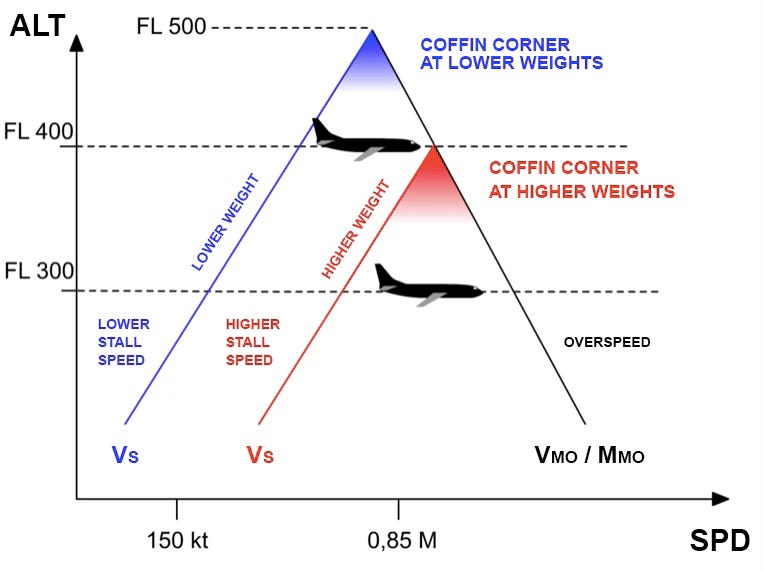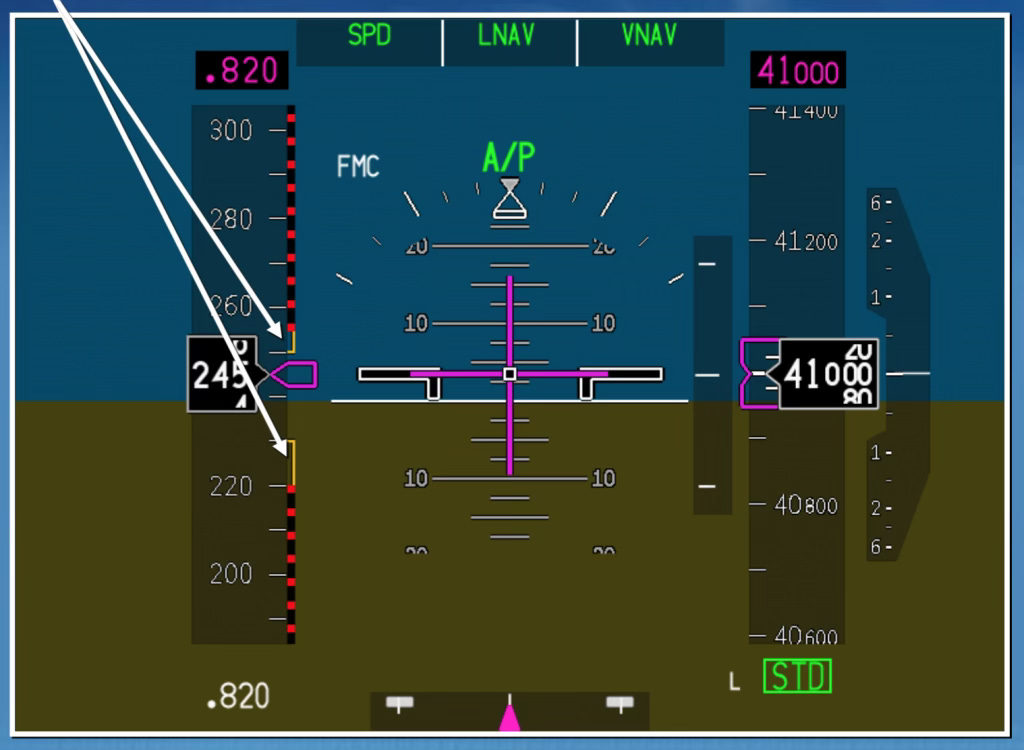The Sky’s Razor’s Edge: Inside Aviation’s Most Dangerous Sweet Spot
Why modern jets flirt with the edge of physics—and what every passenger should know about the mysterious ‘Coffin Corner’
Flying at 40,000 feet seems routine when you're sipping your complimentary peanuts, but up there, pilots are navigating one of aviation's most delicate balancing acts. Today, we're exploring the "coffin corner" – a phenomenon that sounds ominous and, frankly, is exactly as serious as it sounds.
The Simple Explanation
Imagine you're driving a car up a mountain. As you climb higher, your engine struggles more because the air gets thinner. Eventually, you reach a point where your car can barely maintain speed, and if you try to go any faster, the engine might stall. But if you go too slow, you might roll backward down the hill.
The coffin corner is essentially this same predicament, but with airplanes at extreme altitudes except instead of rolling backward, the plane could literally fall out of the sky.
The Physics Behind the Drama
At high altitudes, the air becomes incredibly thin. This creates two major problems for aircraft:
The Speed Squeeze: Aircraft need a certain minimum speed to generate enough lift to stay airborne (called "stall speed"). But they also have a maximum speed they can't exceed without encountering dangerous shock waves and loss of control (called "critical Mach number").
At sea level, there's a comfortable gap between these two speeds – plenty of room to maneuver. But as you climb higher, these two speeds get closer and closer together, like a closing vice.
The Coffin Corner Moment: Eventually, at extreme altitude, these two speeds meet. The plane must fly at exactly one speed – no faster, no slower. This narrow band is the coffin corner, typically occurring around 40,000-50,000 feet for most aircraft.
Why "Coffin" Corner?
The name isn't just dramatic flair. If a pilot accidentally speeds up even slightly, the aircraft could experience a high-speed stall from shock wave formation. If they slow down even a little, the aircraft could experience a low-speed stall from insufficient lift. Either scenario at that altitude could be catastrophic – hence the morbid nickname.
Real-World Implications
For Commercial Aviation: Modern airliners are designed to cruise well below their coffin corner, typically at 35,000-42,000 feet where there's still a safe speed margin. Flight management systems constantly monitor these parameters.
For Military and Test Aircraft: High-performance aircraft like the U-2 spy plane regularly operate near or in the coffin corner. U-2 pilots undergo extensive training to handle this knife-edge flying, where maintaining precise airspeed becomes a matter of survival.
The Weather Factor: Turbulence becomes exponentially more dangerous in the coffin corner. A sudden gust that might barely register at lower altitudes could push an aircraft beyond its safe operating envelope at extreme altitude.
Modern Solutions
Today's aircraft use sophisticated systems to prevent coffin corner emergencies:
Autopilot systems maintain precise speed control
Flight envelope protection prevents pilots from inadvertently entering dangerous conditions
Advanced weather radar helps avoid turbulence at high altitudes
Improved aircraft design extends the safe operating envelope
Seeing the Coffin Corner in Action
To truly understand what pilots face, take a look at this Primary Flight Display (PFD) from an aircraft at 41,000 feet:
Notice the red and amber bands on the left airspeed indicator, these represent the aircraft's operating limits. At this altitude, you can see these warning bands getting very close together. This is the coffin corner visualized in real-time.
The pilot is flying at exactly .820 Mach, threading the needle between the low-speed stall boundary and high-speed buffet limit. According to the FAA Airplane Flying Handbook, the coffin corner is defined as "The flight regime where any increase in airspeed will induce high-speed Mach buffet and any decrease in airspeed will induce low-speed Mach buffet."
In this image, those converging speed tapes show exactly why it's called a "corner" the pilot is literally backed into a corner with nowhere to go but one precise airspeed.
The Human Element
What makes the coffin corner particularly challenging is that it demands perfection from pilots at a time when they have the least margin for error. At 50,000 feet, there's no room for the small corrections and adjustments that characterize normal flight. Every input must be deliberate and precise
Looking Up
The next time you're on a commercial flight cruising peacefully at 38,000 feet, remember that you're in a carefully calculated sweet spot. Your pilots aren't just avoiding the coffin corner – the aircraft is specifically designed and the flight is meticulously planned to give you the smoothest, safest journey possible, well clear of the sky's most unforgiving margin of error.
The coffin corner reminds us that aviation, despite appearing routine, operates on principles that demand both respect and precision. It's a testament to modern engineering and pilot training that what once represented aviation's razor's edge has become a manageable, if serious, aspect of high-altitude flight.
Pilot Nick
✈️ Lessons from the Flight Deck
📬 Get more cockpit insights and travel tips, subscribe free to Lessons From the Flight Deck for weekly updates that help you fly calm and confident or visit:
https://www.skycalm.org










I remember my father discussing coffin corner. He was a test pilot on the Boeing B-47. It was the first USAF swept wing bomber. I believe he was the first in that aircraft to “find” coffin corner. I was vey young at the time, but I recall he escaped by lowering the landing gear to increase drag and lower the critical Mach number. There were a number of other issues like aileron reversal and discovering the stall speed was much higher than predicted. The B-47 was the basis for the Boeing 707.
Thank you for the details!
I’m not a pilot, but am from a family of engineers, and when I researched commercial flight—specifically air speed—I learned why all passenger jets fly at *roughly* the same speed and altitude. We fly on the back of so much applied science and engineering.